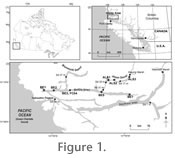| |
INTRODUCTION
 Coastal mainland British Columbia is a geographically complex and vast area, characterized by a mountainous terrain punctuated by numerous fjords that reach far inland. The Seymour-Belize Inlet Complex (SBIC) is one of these fjord systems, situated on the north-central coast of the province (Figure 1). The SBIC is the target of an ongoing multidisciplinary project that is mandated to assess NE Pacific region climate cycles and trends through the Holocene. Assessing paleoceanographic changes based on variation in foraminiferal faunas over time is an important component of this research. Unfortunately, there is very little baseline foraminiferal distributional data available for this region that can be used to interpret Holocene foraminiferal faunas (e.g.,
Schafer et al. 1989;
Patterson and Cameron 1991;
Jonasson and Patterson 1992;
Patterson 1993;
Guilbault et al. 1997;
Guilbault et al. 2003;
Vázquez Riveiros et al. 2007), and only one study focuses in fjord fauna (Schafer et al. 1989). Thus the primary purpose of the research presented here is to fully document and characterize the distribution of foraminiferal faunas from the SBIC, which will provide baseline data for use by future researchers to interpret Holocene and Quaternary deposits from the SBIC and elsewhere along the Pacific Northwest coast. Coastal mainland British Columbia is a geographically complex and vast area, characterized by a mountainous terrain punctuated by numerous fjords that reach far inland. The Seymour-Belize Inlet Complex (SBIC) is one of these fjord systems, situated on the north-central coast of the province (Figure 1). The SBIC is the target of an ongoing multidisciplinary project that is mandated to assess NE Pacific region climate cycles and trends through the Holocene. Assessing paleoceanographic changes based on variation in foraminiferal faunas over time is an important component of this research. Unfortunately, there is very little baseline foraminiferal distributional data available for this region that can be used to interpret Holocene foraminiferal faunas (e.g.,
Schafer et al. 1989;
Patterson and Cameron 1991;
Jonasson and Patterson 1992;
Patterson 1993;
Guilbault et al. 1997;
Guilbault et al. 2003;
Vázquez Riveiros et al. 2007), and only one study focuses in fjord fauna (Schafer et al. 1989). Thus the primary purpose of the research presented here is to fully document and characterize the distribution of foraminiferal faunas from the SBIC, which will provide baseline data for use by future researchers to interpret Holocene and Quaternary deposits from the SBIC and elsewhere along the Pacific Northwest coast.
|